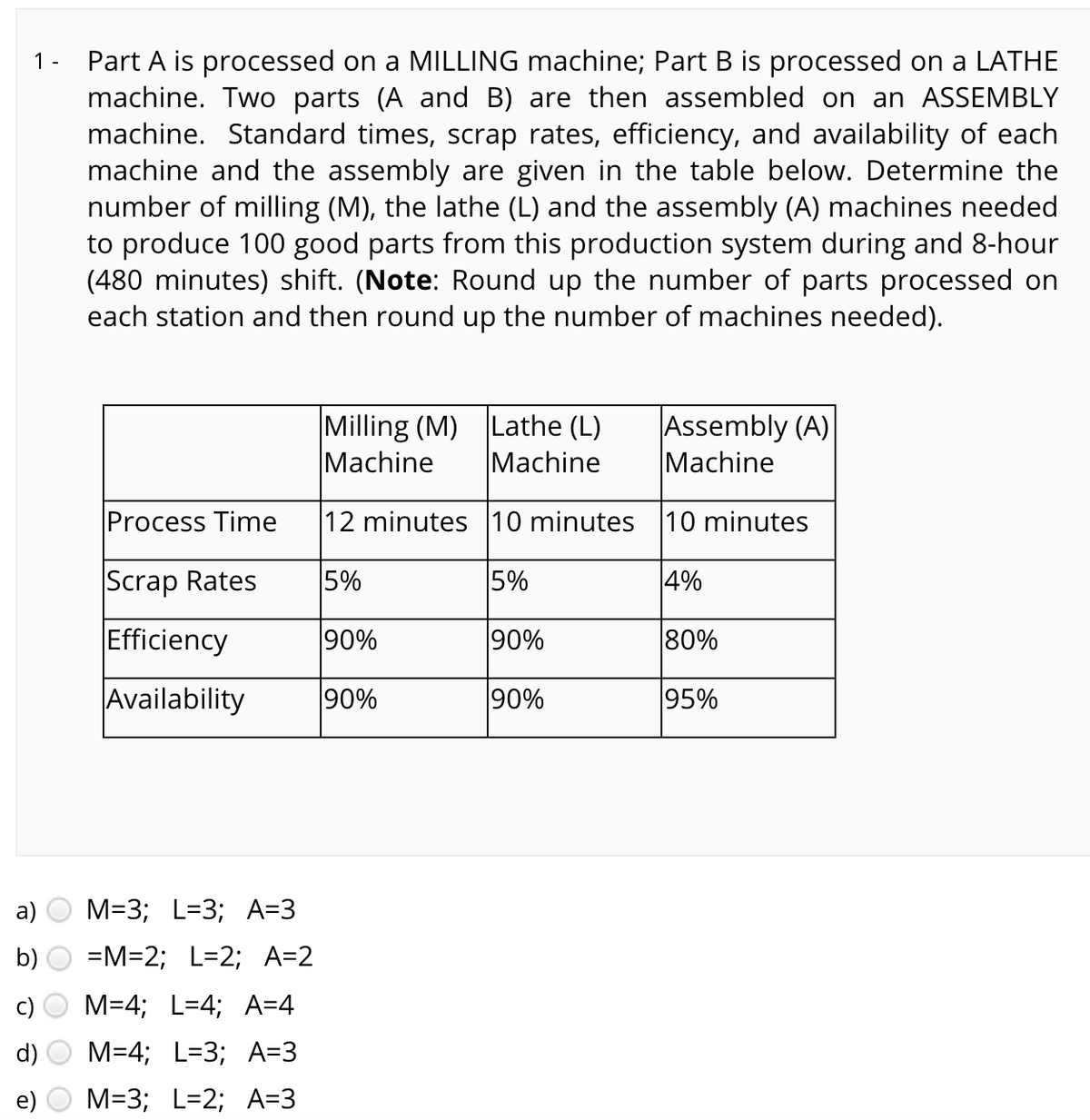Part A is processed on a MILLING machine; Part B is processed on a LATHE machine. Two parts (A and B) are then assembled on an ASSEMBLY machine. Standard times, scrap rates, efficiency, and availability of each machine and the assembly are given in the table below. Determine the number of milling (M), the lathe (L) and the assembly (A) machines needed to produce 100 good parts from this production system during and 8-hour (480 minutes) shift. (Note: Round up the number of parts processed on each station and then round up the number of machines needed)
Part A is processed on a MILLING machine; Part B is processed on a LATHE machine. Two parts (A and B) are then assembled on an ASSEMBLY machine. Standard times, scrap rates, efficiency, and availability of each machine and the assembly are given in the table below. Determine the number of milling (M), the lathe (L) and the assembly (A) machines needed to produce 100 good parts from this production system during and 8-hour (480 minutes) shift. (Note: Round up the number of parts processed on each station and then round up the number of machines needed)
Practical Management Science
6th Edition
ISBN:9781337406659
Author:WINSTON, Wayne L.
Publisher:WINSTON, Wayne L.
Chapter4: Linear Programming Models
Section: Chapter Questions
Problem 111P
Related questions
Question
Part A is processed on a MILLING machine; Part B is processed on a LATHE machine. Two parts (A and B) are then assembled on an ASSEMBLY machine. Standard times, scrap rates, efficiency, and availability of each machine and the assembly are given in the table below. Determine the number of milling (M), the lathe (L) and the assembly (A) machines needed to produce 100 good parts from this production system during and 8-hour (480 minutes) shift. (Note: Round up the number of parts processed on each station and then round up the number of machines needed).

Transcribed Image Text:Part A is processed on a MILLING machine; Part B is processed on a LATHE
machine. Two parts (A and B) are then assembled on an ASSEMBLY
machine. Standard times, scrap rates, efficiency, and availability of each
machine and the assembly are given in the table below. Determine the
number of milling (M), the lathe (L) and the assembly (A) machines needed
to produce 100 good parts from this production system during and 8-hour
(480 minutes) shift. (Note: Round up the number of parts processed on
each station and then round up the number of machines needed).
1 -
Milling (M) Lathe (L)
Machine
|Мachine
Assembly (A)
Machine
Process Time
12 minutes 10 minutes 10 minutes
Scrap Rates
5%
5%
4%
Efficiency
90%
90%
80%
Availability
90%
90%
95%
a)
М-3; L33; А-3
b)
=M=2; L=2; A=2
М-4; L34; А-4
d)
M=4; L=3; A=3
M=3; L=2; A=3
Expert Solution
This question has been solved!
Explore an expertly crafted, step-by-step solution for a thorough understanding of key concepts.
Step by step
Solved in 2 steps with 1 images

Knowledge Booster
Learn more about
Need a deep-dive on the concept behind this application? Look no further. Learn more about this topic, marketing and related others by exploring similar questions and additional content below.Recommended textbooks for you

Practical Management Science
Operations Management
ISBN:
9781337406659
Author:
WINSTON, Wayne L.
Publisher:
Cengage,

Practical Management Science
Operations Management
ISBN:
9781337406659
Author:
WINSTON, Wayne L.
Publisher:
Cengage,